The Remarkable Sixty-Plus-Year Survival of William P. Mahrt's St. Ann Choir
Revised with photos added to a recently published article at the Sacred Music Journal in a special issue dedicated to Prof. Mahrt, long-time CMAA president, who died January 1, 2025
This article was originally based on a talk I gave at the conference titled “The Musical Shape of the Liturgy: Celebrating the Life & Work of William P. Mahrt,” which was put on by the Catholic Institute of Sacred Music at St. Patrick’s Seminary, Menlo Park, California, in November of 2023.
SCROLL DOWN FOR MORE
While the other conference presentations were academic, mine was an informal history of the St. Ann Choir of Palo Alto, which Mahrt directed, and which had celebrated its sixtieth anniversary the month before.
I began to learn about the choir’s unique accomplishments when I sang with the choir for a few years between 2006 and 2008.
The story of the St. Ann choir is so unique and so significant that I want to share it with as many people as possible, in the Catholic world and in the wider culture. It deserves to be much better known.
This article also includes information from several articles I’ve written about Professor Mahrt and the choir during and after the time I was a member. This article is intended to illustrate how Professor Mahrt put into practice the principles that he professed in his scholarship, teaching, and publications, in his role as president of the Church Music Association of America (CMAA), as the publisher of the New Liturgical Movement, and as the editor of this Sacred Music Journal. And it includes my eyewitness account of his last illness, death, and burial, which were accompanied by friends and colleagues often singing the sacred music that he loved and worked so long to preserve.
In 2022, His Excellency Salvatore Cordileone, Archbishop of San Francisco, created the William P. Mahrt Endowed Chair in Sacred Music at St. Patrick’s Seminary and University. In an interview, I asked him, “What made you decide to name the chair after Professor William Mahrt?’
He replied, “Professor Mahrt is a revered world class scholar in sacred music. He teaches at Stanford University only a few miles away from our seminary. . . . For decades at St. Thomas Aquinas Church, also nearby in Palo Alto, the St. Ann choir Professor Mahrt directs has been singing beautiful sacred music at Novus Ordo Masses, according to the current edition of the Roman Missal. He demonstrates how this kind of music is not something that the Church left behind when changing the form of the Mass, but it is actually in keeping with what the Vatican II taught.”
A former attendee at the “Gregorian Mass,” the late René Girard, Stanford Professor Emeritus, who was one of only 40 members, or immortals, of the Académie Française, said this about Bill’s work with the choir:
“When I first attended, I assumed that the Catholic Church and the University actively supported this unique contribution to the spiritual and cultural life of the community. The truth is that ever since 1963, Professor Mahrt has been very much on his own in this enormously time-, talent- and energy-consuming enterprise.” As quoted in Stanford Magazine in “Noteworthy: On Wings of Song” by Cynthia Haven, March/April 2003.
Following is a quote from Prof. Mahrt from a 2013 press release I sent out on the occasion of the choir’s fiftieth anniversary, summarizing the choir’s history:
“The St. Ann Choir began to sing Gregorian chant and polyphony at Mass on the 18th Sunday after Pentecost in 1963 and uniquely continued regularly singing from the Church’s treasury of sacred music at liturgies in diocesan churches—even during the decades while this ancient and hallowed music of the Church was out of favor—and we continue to sing this same music to this day. . . . Our choir started one year before the language changed [from Latin to the vernacular]—if we had tried to start one year later, we might not have been able to do it.”
As Archbishop Cordileone stated, by the choir’s perseverance, it made a unique contribution to the preservation of what the Vatican II Constitution on the Sacred Liturgy called “a treasure of inestimable value.”
The choir continues to sing the Gregorian chants of the day with polyphonic motets on Sundays and also sings polyphonic Masses for special feasts. The weekly inclusion of this music as part of the liturgy, where it belongs, has allowed mass goers to experience it as a living form instead of as a mere academic discipline, as exotic background music, or as an artifact only for traditionalist monks and nuns to sing in their cloisters.
The choir owes its longevity to William P. Mahrt. Mahrt joined the choir when it began at the St. Ann Chapel, which was the chapel for the Stanford University Newman Center. The choir was launched at the beginning of the 1963-1964 academic year, under the leadership of the late Professor William Pohl. Mahrt was 24 years old, just beginning his first year as a Ph.D. candidate at Stanford University. A year later Mahrt became the choir’s director when Pohl took an academic job in another state. Except for two absences for a combined total of five years, Mahrt directed the choir during most of its history, until his recent death. [You’ll find more details about the choir’s founding later in this article.]
Before he died, Mahrt created a foundation to ensure the continuation of the choir, and it continues to sing every Sunday at 11 AM at St. Thomas Aquinas Church, in Palo Alto, now directed by Dr. Erick Arenas, and for special feasts at either St. Thomas Aquinas Church or at St. Ann Chapel by gracious permission from the current owners. Arenas joined the choir twenty years ago this coming September, when he came to Stanford to work on a Ph.D. in Musicology in the Fall of 2005. Over the years, Professor Mahrt began to ask him to lead the choir on occasion, and starting in 2018, Arenas regularly took over directing duties when Mahrt was not available.
Let’s Call Him Bill
“I called him once Dr. Mahrt and he said, ‘Call me Bill!’— Dr. Horst Bucholz, who served as Vice-president with Bill as President of the CMAA for eighteen years.[1]
Because he encouraged most people to call him Bill, I will use that to refer to him from now on.
I was never a close friend, but I quickly became an admirer of what he had accomplished. I interviewed him a few times for articles [2] I wrote about the choir, and we would chat briefly once in a while at public events. After I left the choir in 2008 to sing in a newly formed schola at an oratory dedicated to the traditional Latin Mass in San José, I continued to design flyers and manage a MailChimp list I created to send out announcements about St. Ann Choir events. And from time to time I came to Masses at St. Thomas Aquinas Church to hear the choir sing polyphonic Masses at special feasts.
My visits stopped in 2022 when I cut way back on my driving after a few accidents. In the Fall of 2024, I started getting rides there again from Stewart Shipley, a tenor who has sung with the choir since the 1990s, so I started coming to the Masses at which the choir sings about once a month, and I would help set up the food for what Bill referred to as the after-Mass collation while Stewart rehearsed with the choir.
I learned by talking with Bill after Mass one Sunday last Fall that he had retired from Stanford at the end of the 2023-2024 academic year the previous Spring, and he was still quite busy preparing papers and traveling to give talks nationally and internationally. On another Sunday in early December, he mentioned that doctors told him the prostate cancer he had been living with for decades had metastasized, but he said they didn’t know where. Because of Bill’s reserve on personal matters. I didn’t feel I could ask follow-up questions, but I could tell he was concerned about the diagnosis. That was the last time we ever talked. The next time I saw him he was in a coma in the Stanford ICU after a stroke that turned out to be fatal.
On Sunday, December 29, 2024, Bill was on his way to lead choir practice before Mass when he collapsed on the sidewalk outside his Stanford condominium. Neighbors who came across him called the ambulance that took him to Stanford Hospital, where he was diagnosed with kidney failure. Bill managed to call Erick Arenas and ask him to lead the choir that day, and Erick told Bill he would call the next day to check in with him about future arrangements, in case Bill didn’t spring back as he had so often remarkably done from other health crises.
Erick told me later that although the choir had practiced the motets for that week during the usual Thursday choir practice, and everyone already had the music for the motets in their choir binders, there was a scramble to get the scores for the ordinary and propers of the Mass. The solution hastily arrived at, on the suggestion of Stewart Shipley, was that those who had smartphones could read the music online from the Institute of Christ the King website. So, for the first time in the choir’s history, the choir sang from smartphones, instead of the large format chant pages they normally used.
Later on Sunday after his phone call with Erick, Bill was given dialysis. Sometime before the next morning, before Erick had a chance to talk with him again, Bill had a massive stroke, went into a coma, and died a few days later, on January 1, 2025, at the age of 85.
I was one out of a stream of many other St. Ann Choir friends, former students, and admirers, who came and stayed for varying lengths of time and kept a vigil at his bedside from Monday when the news got out until he died on Wednesday.
Bill was a lifelong bachelor, and his family couldn’t be located until after his death, so it was a blessing that he was accompanied by so many who cared about him. Father William [Donald] Morgan, who often celebrates Masses at St. Thomas Aquinas Church where the choir usually sings, stayed in Bill’s room for most of the time Bill was in the ICU, and he was one of two priests who gave Bill the Last Rites and the Apostolic Pardon. Bill was not only abundantly accompanied spiritually, many of us who stood vigil with him sang the Church’s traditional sacred music that he loved for him, before and after he died—what must have been a never-before-heard-of thing to happen at the Stanford ICU.
Bill’s wake was also extraordinarily musical. It was held in St. Thomas Aquinas Church, and instead of eulogies, we all chanted Vespers and Compline. The funeral, which was celebrated at Mission Dolores Basilica in San Francisco, was a traditional Solemn Requiem Mass, sung by 70 singers who came from all over the country to honor Bill. And the reception held afterward was also unusual, because—interspersed with recollections by choir members and friends—some of the choir’s favorite motets were sung, in a chant sing-along.
“Fittingly, although quite unusually, his last days in Stanford Hospital's ICU, his wake, his funeral, and even the reception afterward—were all accompanied by the singing of the Church's traditional music, which he championed.”— From “A Sacred Farewell: Honoring William Mahrt and His Legacy in Sacred Music.”[3]
Archbishop Cordileone was among the hundreds who were praying for Bill in his final hours. After Mahrt's death, the archbishop said, “The successful revival of Gregorian chant and sacred polyphony in this country owes much to the gifts, the generosity, and the persistence of this great human being."
How I got to be the unofficial historian of the St. Ann Choir
On Tuesday, November 7, 2023, the first day of the Mahrt conference, Mary Jane Ballou, harpist, organist, and director of Cantorae St. Augustine, who I met twenty or so years ago at a Church Music Association colloquium, asked me, “Why are you giving this talk on the choir’s history?” As in, why you of all people?
I know Mary Jane didn’t mean her question maliciously. She was just curious. I think she meant, “Do you have any special knowledge?”
I gladly admit that most of the choir’s members know much more about the day-to-day, year-to-year history of the choir than I do. Many have given countless hours of free time for multiple decades, some even since the 1960s and the 1970s. The simple fact why I compiled this history instead of anyone else is that I’m the one who volunteered.
And the reason I volunteered is this: during the few years when I was in the choir—during which I attended two CMAA colloquia, did a lot of reading on the subject of sacred music, and listened to and interviewed Bill—I glimpsed a bigger picture, that the St. Ann Choir’s achievement is almost unique in the English-speaking world.
I’m neither a musician nor an academic. I’m a poet, a memoirist, and a writer who also publishes work in many genres. I write as a passionate amateur about whatever captures my Catholic imagination, Catholic in the broad sense of universal, but also in the specific sense of being a devout believer in the Catholic faith. Poet Dana Gioia has referred me to several times as a cultural journalist.
I didn’t realize when I started singing with the St. Ann Choir, but I had a lot to learn. Before I joined, I actually thought I knew all there was to know about Gregorian Chant—because when I was in the fourth grade in the Ascension parochial school in a rundown area of Worcester, Massachusetts, a religious Sister of Notre Dame started a children’s choir, and we learned to sing the simple ordinary parts of the Mass, probably the Missa De Angelis, at Sunday Masses in the 1950s. I had no idea what a beautiful world of chant and polyphony was going to open for me when I started singing in Bill’s choir.
Various choir members have tried to publicize the choir’s work to bring in a wider audience. It seemed like a good idea to me too, until I thought about it. Then I realized the music sung by the choir was never going to get a secular following, as some non-Catholic choir members who loved the music and revered Bill seemed to hope. Anyone interested, Catholic or not, would be welcome, but most non-Catholics would not attend liturgies in a Catholic Church for the music alone. And if they did, it wouldn’t be appropriate for people to attend sacred liturgies as if going to a concert. So, the biggest reason that the choir could never find a wide secular audience is that the music is inseparable from the liturgy.
Gregorian chant is the Church's sacred music, and the chanting of the words of the Mass developed as an intrinsic part of the liturgy. It is unique among all types of music because it has always been used only for worship. Gregorian chant is ‘sung prayer."
Mahrt worked to combat a widespread misunderstanding, that the Second Vatican Council had outlawed the Church's traditional music. As he frequently emphasized, Vatican II never mandated that the rich treasury of Gregorian chants and polyphonic hymns in Latin should be abandoned. On the contrary, they were held up as being intrinsic to the Mass and uniquely suited to Catholic worship.
After what I had painfully experienced with my own ears about the state of Catholic Church music after the Second Vatican Council, I was amazed and grateful that under Bill’s direction, the choir managed to keep on singing Gregorian Chant and Renaissance polyphony even during the long decades when that kind of music was virtually banned.
And they weren’t singing in a monastery or a convent. They weren’t singing at traditional Latin Masses. Ever since the new Mass was mandated after Vatican II, the choir has been singing at Masses according to the Missal of 1969, which are sometimes called the novus ordo and what Pope Benedict XVI called Ordinary Form Masses, and they were singing in liturgies in regular diocesan churches.
And somehow they got away with it! (Bill told me one time that he credits the choir’s survival to the intercession of St. Ann, the choir’s patron saint.)
Mahrt’s Account of the Choir’s Founding
The first time the choir sang was on October 6, 1963. Even though the Masses at which they sing follow the new calendar, the choir observes its anniversary each year on the date on which the 18th Sunday after Pentecost falls, because that is the Sunday in the traditional liturgical calendar on which they first sang the Mass.
Unless noted, the following quotations are excerpts from Bill’s unpublished history of the founding of the choir.[4]
“On the Nineteenth Sunday after Pentecost,[5] 1963, a new choir began to sing for a High Mass at St. Ann Chapel, the Newman Center for Stanford in Palo Alto. . . .
“The choir was founded by William F. Pohl who had sung chant in school and college and who had begun a chant Mass at Berkeley when he was a doctoral student. He came to Stanford as a junior faculty member in mathematics and proposed the chant Mass for St. Ann Chapel. . . .
“He saw in the highest liturgical music . . . a preeminent goal—to effect in the listener a joy very much akin to the delight of intellectual discovery, something which led Medieval musicians to compose music according to geometric principles, and also led to harmony as we know it today.
“Later music sometimes aimed less at contemplative joy, than at dramatic effect, or simply at pleasing the hearers. The liturgy should be first and foremost contemplative—only when this is achieved will excesses be avoided which replace contemplation with activity, ceremonies with mere pageantry.”
The summer before Pohl started the St. Ann Choir, Mahrt and Pohl had met each other by chance, again according to Mahrt’s account.
“I was a graduate student in music at the University of Washington, singing chant for Masses at churches in Seattle. During the Summer, when choirs were on vacation a group of us prepared a polyphonic Mass and sang it on the last Sunday of July at the local Dominican church, the only Mass we sang the whole summer. After the Mass there appeared William Pohl, who was attending a mathematics conference, the only one that summer. He told me he was beginning a chant choir at Stanford, and I surprised him by saying I would go to Stanford as a graduate student in the Fall. I thereby was at the rehearsal of the new St. Ann Choir and its first Mass. The new choir was for a High Mass sung by the priest, with Gregorian chant propers by the choir, Gregorian chant ordinary for the congregation [Ed.: which the choir also sang], occasional motets in classical polyphony, and organ music.”
When the St. Ann Choir started, the Second Vatican Council was just beginning. The Mass of 1969, which is now the norm, was six years in the future. All the Masses at that time were in the form of what is now called the traditional Latin Mass, the Tridentine Mass, the Extraordinary Form of the Mass, the Vetus Ordo, or the usus antiquor. The traditional Latin Mass, which was then the only form of the Mass in the Roman rite, was celebrated according to the reformed Missal of 1962, which is called the Missal of John XXIII.
Experimentation during Masses was rampant in many places, and it was often quite distracting from the sacrifice of the Mass. Some priests seemed to think that since improvisation was allowed, it was actually required. Here’s a sampling from my experience. One kind of musical improvisation I heard of when I lived in Minnesota was the use of polka Masses celebrated for the Polish Governor at the time, Rudy Perpich. At the parish closest to the University of Minnesota, which I started to attend in the mid-1970s after I came back to the Catholic Church after lapsing as a college freshman, the Masses were accompanied by hippy musicians playing folk songs. Having once been a hippy myself, I have nothing against hippy musicians or folk songs, but it began to seem wrong to me after a while that the focus of the Mass had shifted to the musicians and the other laypeople who assumed new roles in the liturgy rather than on the sacrifice of the Mass.
In contrast with prevalent musical trends towards entertainment during Mass, Pohl believed liturgy should foster contemplation, and Gregorian chant was the ideal form of music for the purpose. His original plan was for the choir to continue to sing the normal Latin Mass of 1962 with Gregorian chant, and for preludes and postludes Professor Pohl played the organ.
Soon after the choir’s creation, Pohl’s convictions were reinforced rather than challenged by the December 4, 1963 publication of Sacrosanctum Concilium, the Constitution on Sacred Liturgy. As readers of this journal probably know, this was the first formal document issued by the Second Vatican Council.
"The musical tradition of the universal Church is a treasure of inestimable value, greater even than that of any other art. The main reason for this pre-eminence is that, as a combination of sacred music and words, it forms a necessary or integral part of the solemn liturgy.”— Second Vatican Council, Constitution on the Sacred Liturgy, Sacrosanctum Concilium §112
The year after the choir started, William Pohl left Stanford for the University of Minnesota where he taught mathematics from September 1964 until his early death in 1988 at the age of 51, in the 25th year after the choir’s founding. Pohl had remained close friends with Bill Mahrt until his death. Bill sang at two Requiem Masses for Pohl in Minnesota, and the St. Ann Choir sang a Mass for Pohl at the St. Ann Chapel.
“The liturgy should be first and foremost contemplative—only when this is achieved will excesses be avoided which replace contemplation with activity, ceremonies with mere pageantry.”— William F. Pohl, "Liturgical Music and the Liturgical Movement," unpublished paper c. 1964.
Returning to Bill’s unpublished history, “In the same year as the founding of the choir, 1963, the Second Vatican Council issued its first formal document The Constitution on the Sacred Liturgy. While it allowed the use of local vernaculars for the first time in the Roman rite, it retained Gregorian chant sung in Latin as its normative music; it gave a special role to the polyphonic music of the Renaissance and endorsed the pipe organ as the proper instrument for sacred music. Subsequent Roman documents underscored these principles.”
It sometimes puzzles me greatly when I reflect that these instructions had been almost universally ignored for decades after Vatican II, “honored more in the breach than the observance.”
When Professor Pohl left Stanford in 1964, he turned the choir over to Bill, who was still a graduate student. Bill directed the choir from 1964-1966 and again between 1967-1969, until he earned his doctorate. After Bill finished his Ph.D. in Musicology, in 1969, he held teaching positions at Case Western Reserve University and the Eastman School of Music.
He returned to join the Stanford faculty in 1972, and he resumed directing the choir the next year.
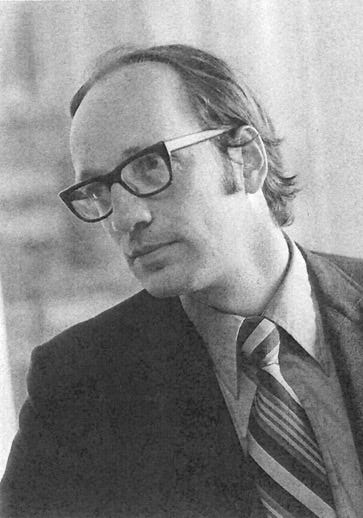
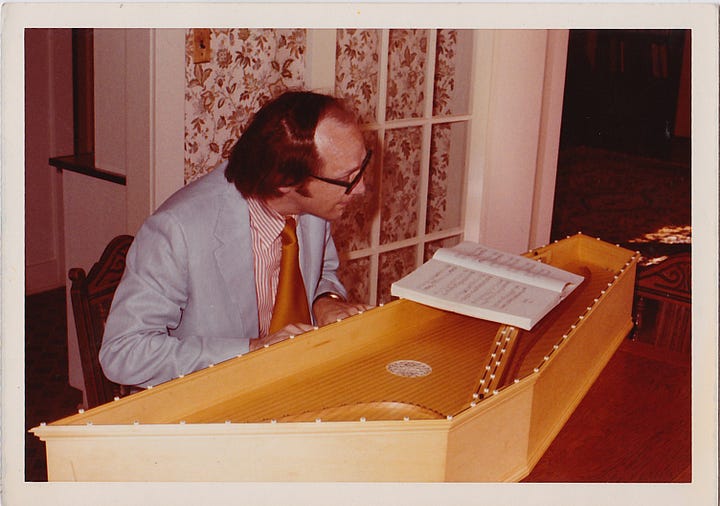
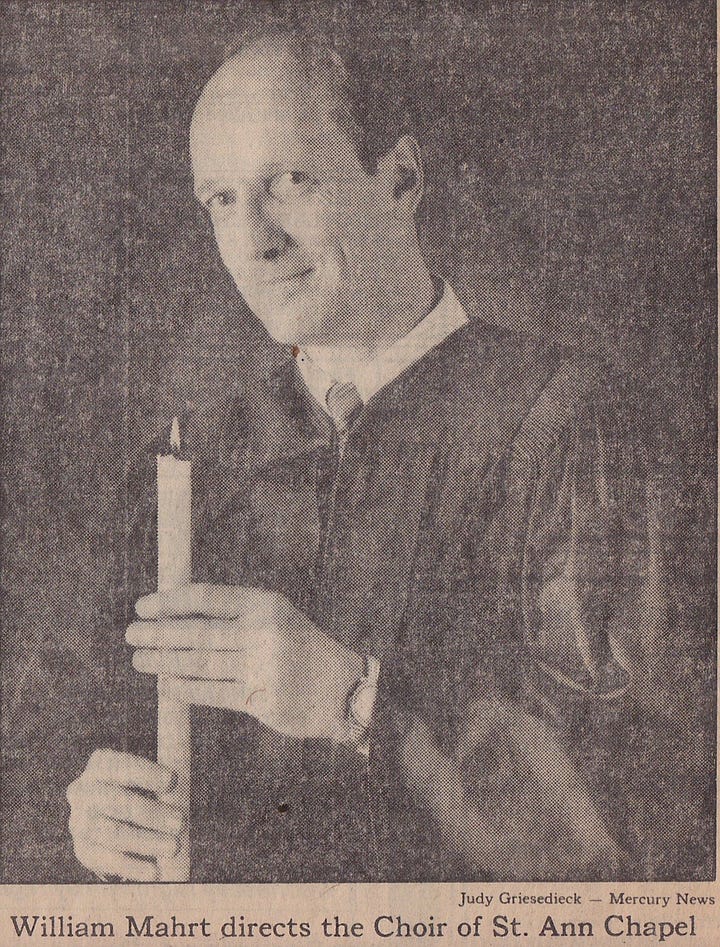

In his choir history, Bill continued, writing about himself in the third person:
“Mahrt thus saw in the documents of the Council a charter for the continued use of chant and polyphony in the liturgy, and when the vernacularization began, the chant continued to be sung in Latin.
“Some experiments were made with chant in English particularly for Holy Week; years of trial, however, lead to the conclusion that it was best in Latin, though several pieces remain in English from that time, notably the Lord's Prayer at Mass and the antiphons at the Maundy for Holy Thursday. These and other liturgical questions were the subject of some controversy during the middle sixties, and for the spring quarter of 1968, the Gregorian Mass was relegated to Saturday evening. By that summer, however, it was resumed on Sunday morning, and the matter was considered settled.”
Under Bill’s leadership, the choir expanded its repertoire. But he often stated that the choir’s main accomplishment is that they continued to follow Pohl’s original plan until this day.
In St. Paul, Minnesota, Professor Pohl became active in singing and leading the choir at St. Agnes Church, which is famous in CMAA circles as the church where Fr. Robert Schuler founded a great music program that included many orchestral Masses that were hardly ever heard sung after the Second Vatican Council.
I found this quote about Pohl in a post at a Catholic Forum about Sacred Choral Music at Saint Agnes.
“In the early 1970s, Dr. William F. Pohl, a professor of mathematics at the University of Minnesota, sang the Gregorian chant, mostly solo, while developing a small schola of Chorale volunteers to assist him. Dr. Pohl guided the chant during the aftermath of the Second Vatican Council when all the liturgical books were being revised, no small task, but as some may recall, he was no small man.”
Because of Pohl’s weight, those who wrote about him often mentioned he was big—in more ways than one. When I told Professor Mahrt this observation, he agreed, with a laugh. “Yes, he was Big, in more ways than one.”
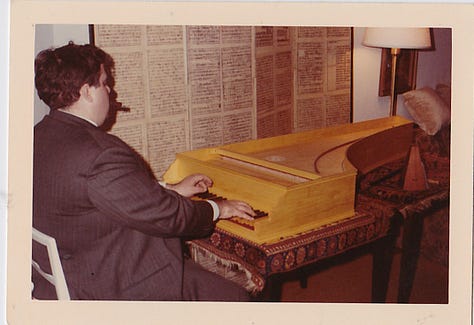
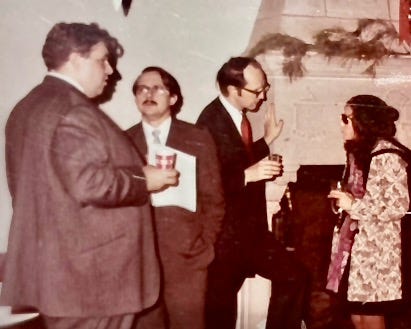
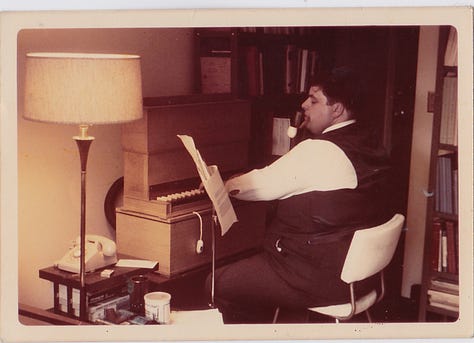
After Pope Paul VI promulgated the new Roman Missal in 1969, metrical hymns quickly replaced Gregorian chant at most vernacular Masses. In Palo Alto, however, the St. Ann Choir continued to sing the propers and congregational ordinaries in Latin. In the following years, the choir experimented with English chant, as Bill notes in his history. Even so, the choir soon returned to chanting ordinary and propers in Latin Gregorian chant because as Bill stated elsewhere, the experiment failed because the Latin text and the music align so perfectly. Until 2001, the priest routinely chanted Mass dialogues and orations in English while the choir sang propers in Latin. At that point, Fr. Francisco Nahoe, OFM Conv., a frequent celebrant for many of the choir’s liturgies in this period, transitioned to singing the entire Mass ordinary in Latin. Thereafter, whenever the choir sings, the priest now always chants the celebrant parts in Latin.
Incidentally, Professor Mahrt, some choir members, and friends of the St. Ann Choir often remarked that a good thing about the choir is that many of its members are not Catholic. Traditional Catholics like myself may wonder at the appropriateness of including non-believers in a choir, which performs a liturgical function. But the idea of inclusiveness appeals to many both inside and outside the Catholic Faith. As Early Music singer Miriam Palm told me after the Mahrt conference, “The non-Catholics are loyal to Bill and love the music.”
The Choir’s Beginnings at the St. Ann Chapel
The St. Ann choir first began singing at Masses at St. Ann Chapel, which has a complex and fascinating history of its own. At the time the choir started in 1963, St. Ann Chapel was 12 years old. It had been built by Ambassador, Congresswoman, and playwright, Clare Boothe Luce, wife of the publishing giant Henry Luce, and donated for use by Stanford University’s Catholic Newman Center. The chapel was dedicated to St. Ann as a memorial to Luce’s daughter, Ann Brokaw, who had died in an accident months before she was to graduate from Stanford in 1944.
Luce intended the chapel to be a small gem to illustrate that modernism and sacred art are compatible, and she commissioned artists to decorate the chapel with expressionistic (and experimental) painted windows instead of stained glass, painted stations of the Cross, a cubist-inspired mosaic of the Blessed Virgin, and a steel mesh flat canopy over the altar decorated with mosaics and Cubist-inspired angels. A very large impressionistic green bronze of St. Ann with the Virgin Mary is mounted over the entrance to the flat red, brick front of the chapel.
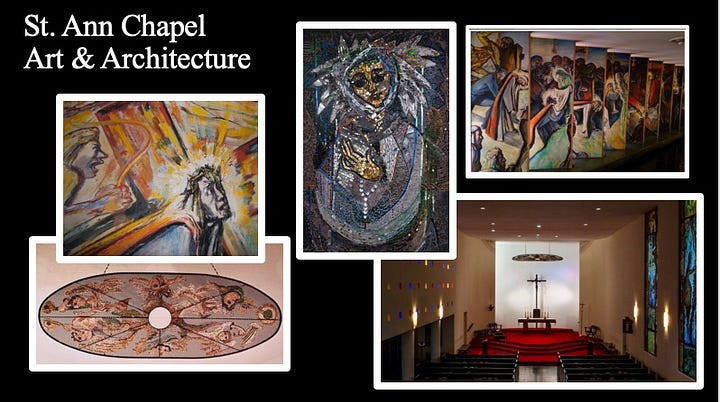
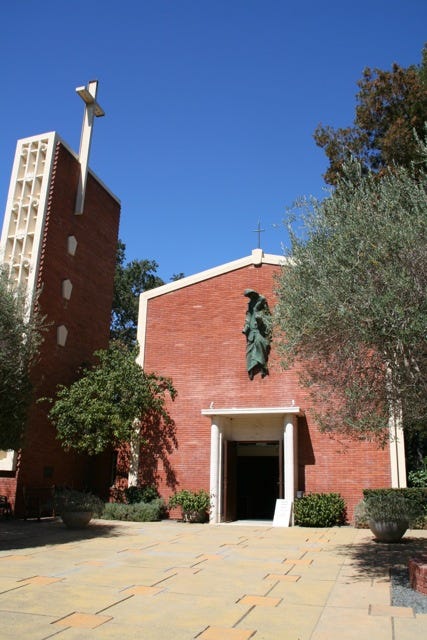
The St. Ann Chapel was built adjacent to Norris House, a historic Spanish Revival house built in 1927 for Kathleen Norris, a writer who was once the highest-paid female author in the United States, and her husband Charles Gilman Norris, also a noted novelist. In 1949, the Archdiocese of San Francisco had purchased the house to serve as the Newman Center for Stanford University, and when the St. Ann Chapel was completed in 1951 it became the Newman Center Chapel.
Forty-six years later, Stanford University sold the chapel.
“In 1997, under the title of St. Dominic Parish, the Stanford Catholic Community became a parish of its own and in 1999 St. Ann's Chapel was sold. The Gregorian [chant] masses that had been celebrated at St. Ann’s chapel by the St. Ann’s choir since 1963 moved to St. Thomas Aquinas church.”—St. Thomas Aquinas Parish, Palo Alto, CA - Diocese of San José, “A brief history[2]”[6]
The proceeds from selling the Norris house and St. Ann Chapel were used to finance the new Parish of St. Dominic to serve the transferred Newman Center on campus. The old Newman Center house became a private home of a Silicon Valley executive.
There was some talk about demolishing the chapel. Bill knew that destruction of the chapel or the possible sale for reuse for a secular purpose would violate the original terms of the Luce family’s donation of the chapel to Stanford, and he contacted the Henry Luce Foundation, which stepped in to buy the chapel back from the university. Attempts were made to keep the chapel as a place of Catholic worship. The Thomas Merton Foundation leased it for a time and tried to buy it but couldn’t raise the million-dollar asking price.
In April 2003, the chapel was sold to the Anglican Province of Christ the King, a conservative Anglican offshoot dedicated to praying from the 1928 Book of Common Prayer.
Ever since 1998, the choir has been singing at Sunday Masses at St. Thomas Aquinas Church, another historic Palo Alto church. The church, located at 751 Waverly Street (at Homer) at the northern edge of the “Professorville” neighborhood, was built in 1902, designed by architects Shea and Shea of San Francisco, who had built the Bank of Italy and Mission Dolores Basilica. The church’s architectural style is called Carpenter Gothic, which is derived from the Gothic Revival movement in 18th-century England. The 19th-century Carpenter Gothic movement in America adapted Gothic elements such as pointed arches, steep gables, and towers to traditional American light-frame construction using the locally abundantly available wood.
The Church exterior, originally painted yellow, has these carpenter Gothic features, a prominent steeple, shiplap siding, repetitive bays with stained glass, steep gables, carved rosettes, parapets, and quatrefoil windows.
At St. Ann Chapel where the choir first began in 1963, paint is peeling from the painted windows and the colors have faded. The modernist style of architecture and art has lost much of its appeal over the decades, but the choir has been able to maintain its own nostalgic attachment by continuing to sing Vespers there on most Sundays by the gracious invitation of the Anglican Archbishop, Robert Morse.
Fond Remembrances
Some friends and members of the St. Ann Choir join for Sunday Compline over Zoom every Sunday night.
They say this Latin prayer at the end of every Compline:
Divinum auxilum maneat semper nobiscum. Et cum fratribus nostris absentibus.
May the divine assistance remain always with us. And with our absent brethren.
In my St. Ann Choir history presentation at the Mahrt conference, I wrote that the choir fondly remembers: “Walt Baxter, George Brown, René Girard, Mary Fischer, Brian Howard, Mary Keirstead, Lalu Kiesling, William Pohl, Nancy Ritter, Joe Scaroni, David Webb, and all other St. Ann choir members and friends with whom we have lost touch, who may also have died—without our knowing—and for whom we are grateful for their generous contributions of time, talent, and support.” And now, to the top of this list of fondly remembered and well-loved contributors, we add William P. Mahrt. May the divine assistance remain always with him.
[1] Jeff Ostrowski. “Remembering William Mahrt: Jeff Ostrowski interviews Dr. Horst Buckholz,” Views from the Choir Loft at Corpus Christi Watershed, January 22, 2025 (accessed March 14, 2025).
[2] See also the Substack “The Remarkable Sixty-year Survival of Professor Mahrt’s St. Ann Choir,” which has the slides for the talk at the Mahrt conference and many more, all of which have many photos and more details about the choir.
Also, check out this page of links and scanned articles. Most of the linked articles are by me. Articles by Carrie Sturrock at the San Francisco Chronicle, by Cynthia Haven at Stanford Magazine and Stanford News, and by others are linked at the end. Scans of the articles are included when they are not online:
Articles about the Palo Alto Choir that kept chant and polyphony alive in worship for over 60 years
[3] Roseanne T. Sullivan, “A Sacred Farewell: Honoring William Mahrt and His Legacy in Sacred Music,” originally published at National Catholic Register (January 25, 2025) and expanded at my Roseanne T. Sullivan Substack here:
[4] William P. Mahrt, ‘A Brief History of the St. Ann Chapel Choir,” unpublished (date uncertain).
[5] Although Bill’s history states the choir began to sing on the Nineteenth Sunday after Pentecost, in the years when I was publicizing the choir’s anniversaries, Bill always told me that the choir began on the Eighteenth Sunday after Pentecost, October 6, 1963, and I’ve verified that October 6 fell on the Eighteenth Sunday after Pentecost in 1963.
[6] _____. “A brief history,” St. Thomas Aquinas Parish, Palo Alto, CA - Diocese of San José.
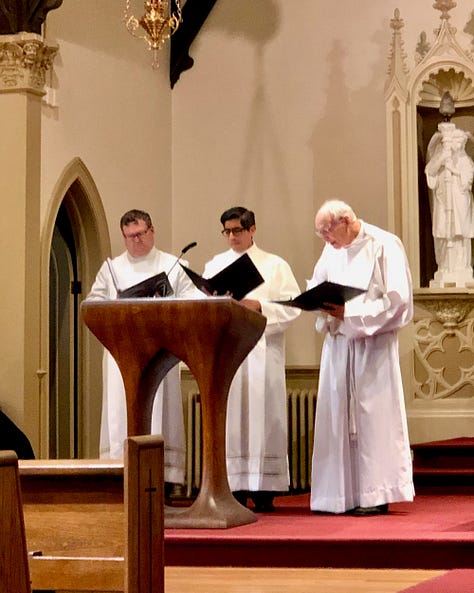
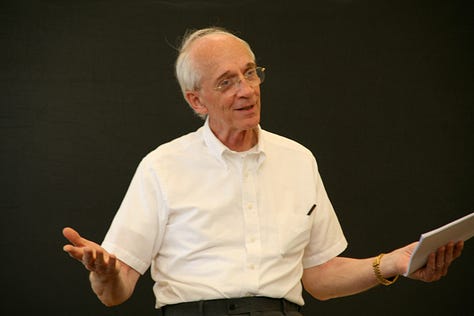
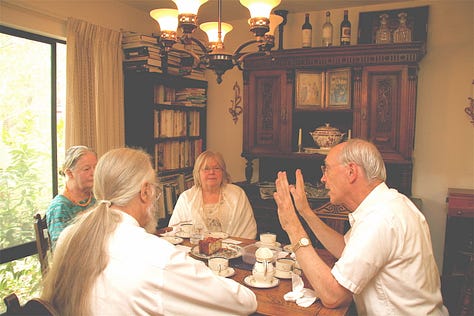
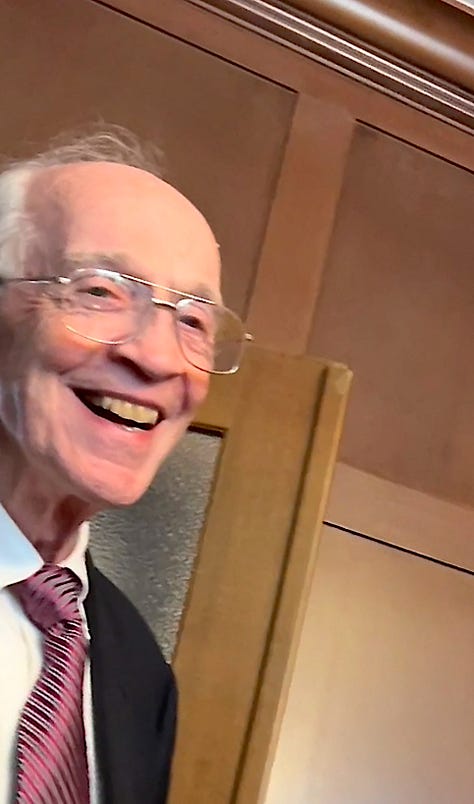
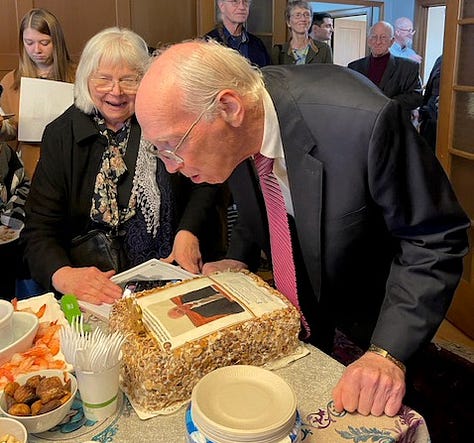
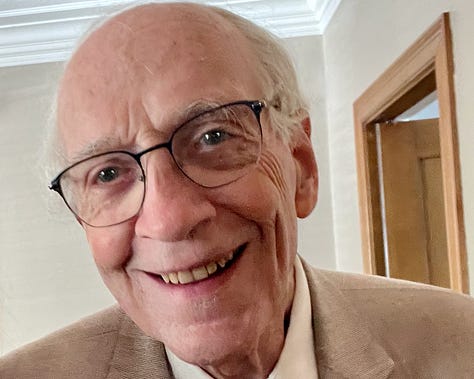
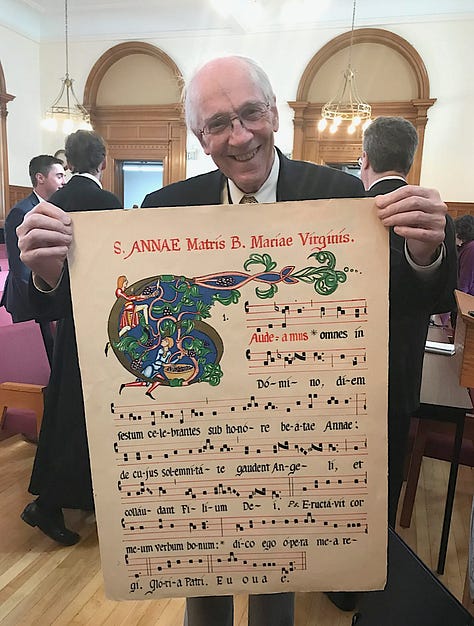






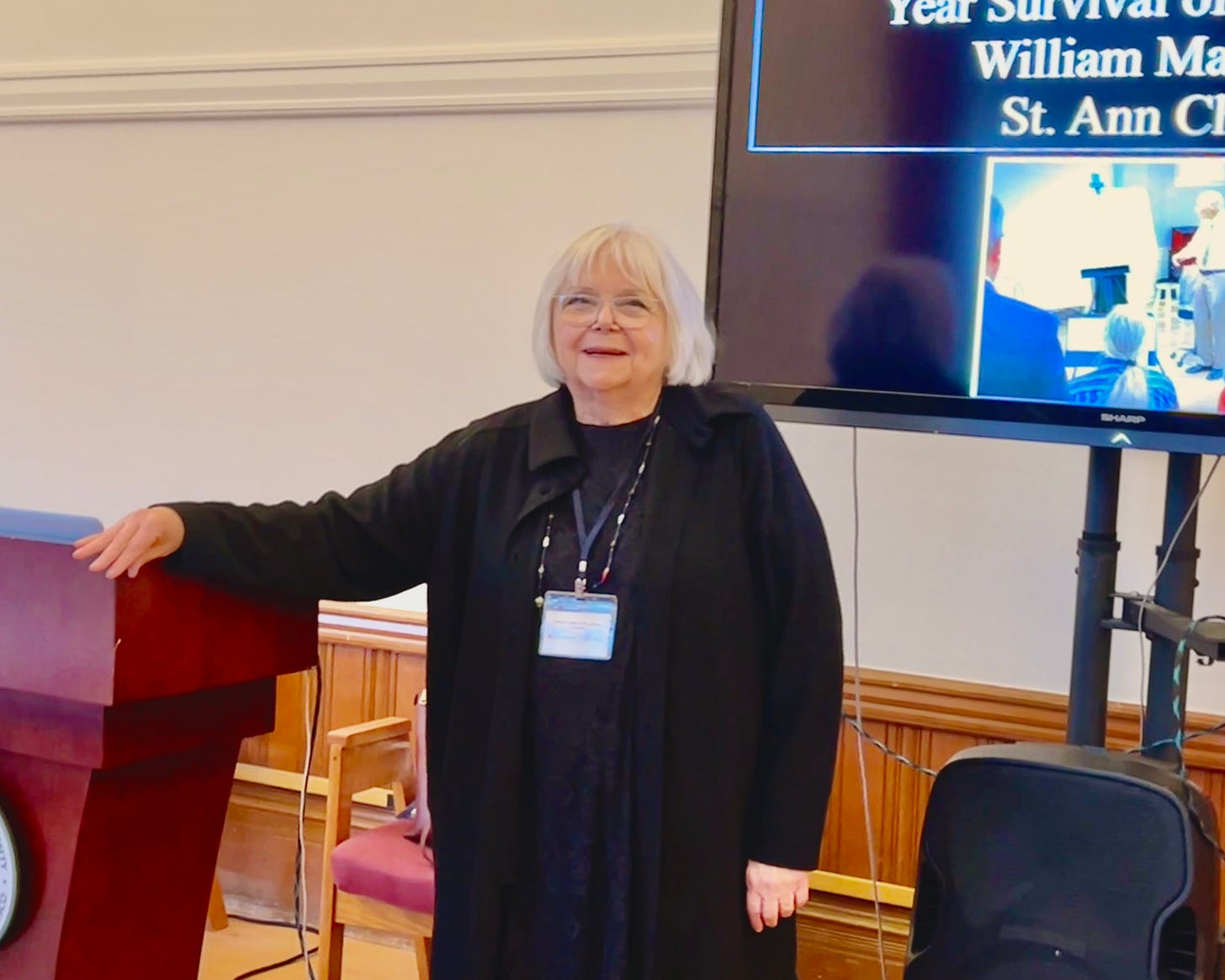



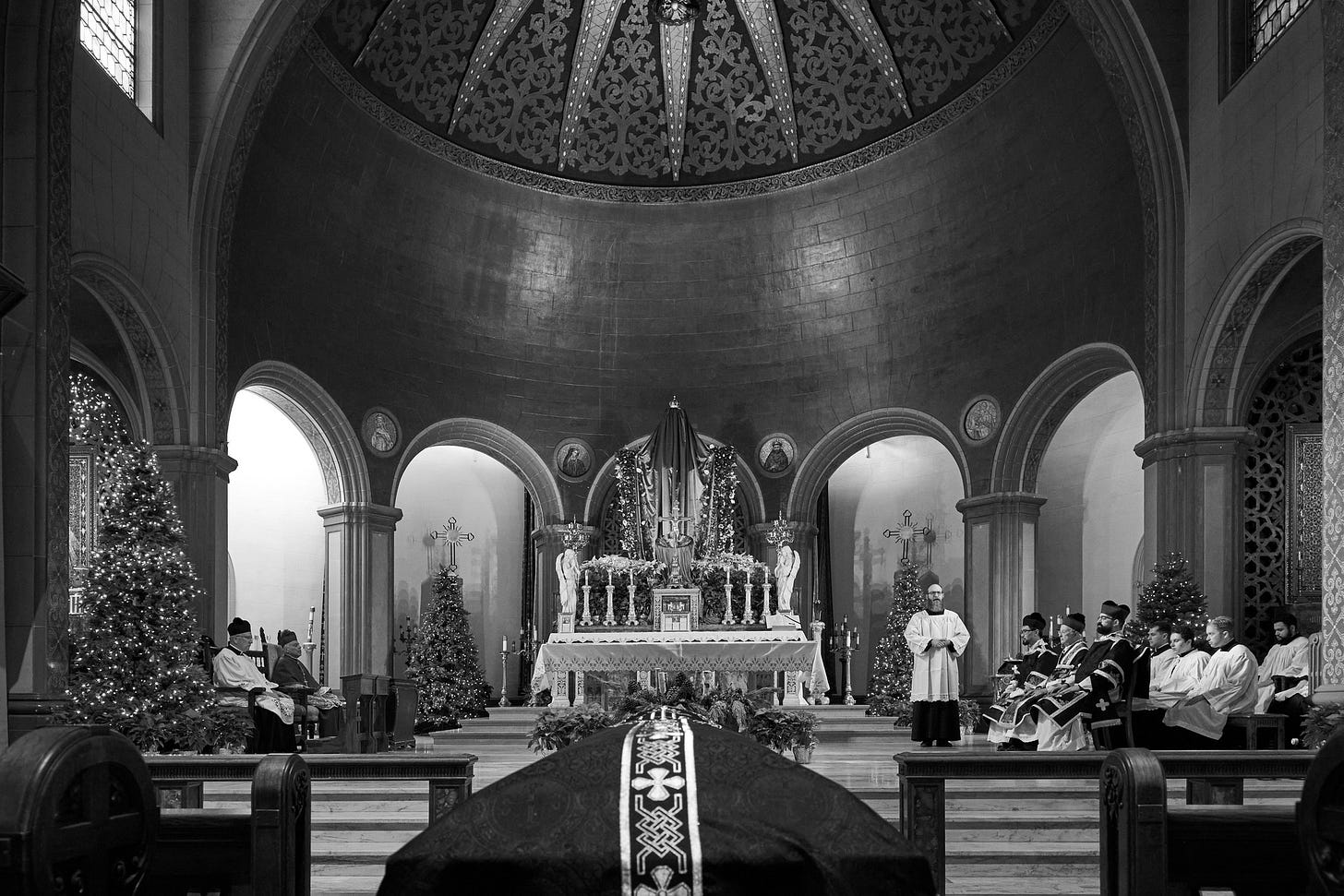
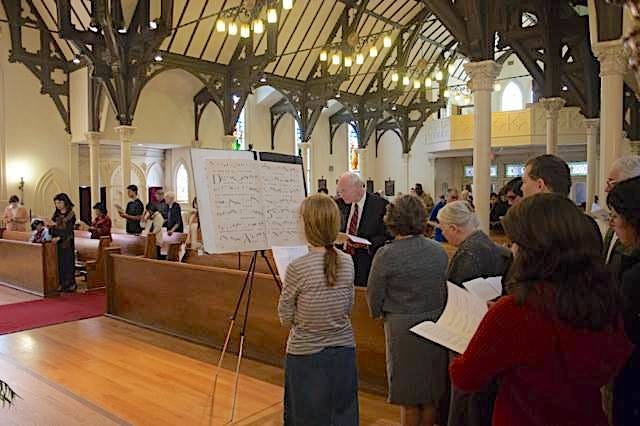
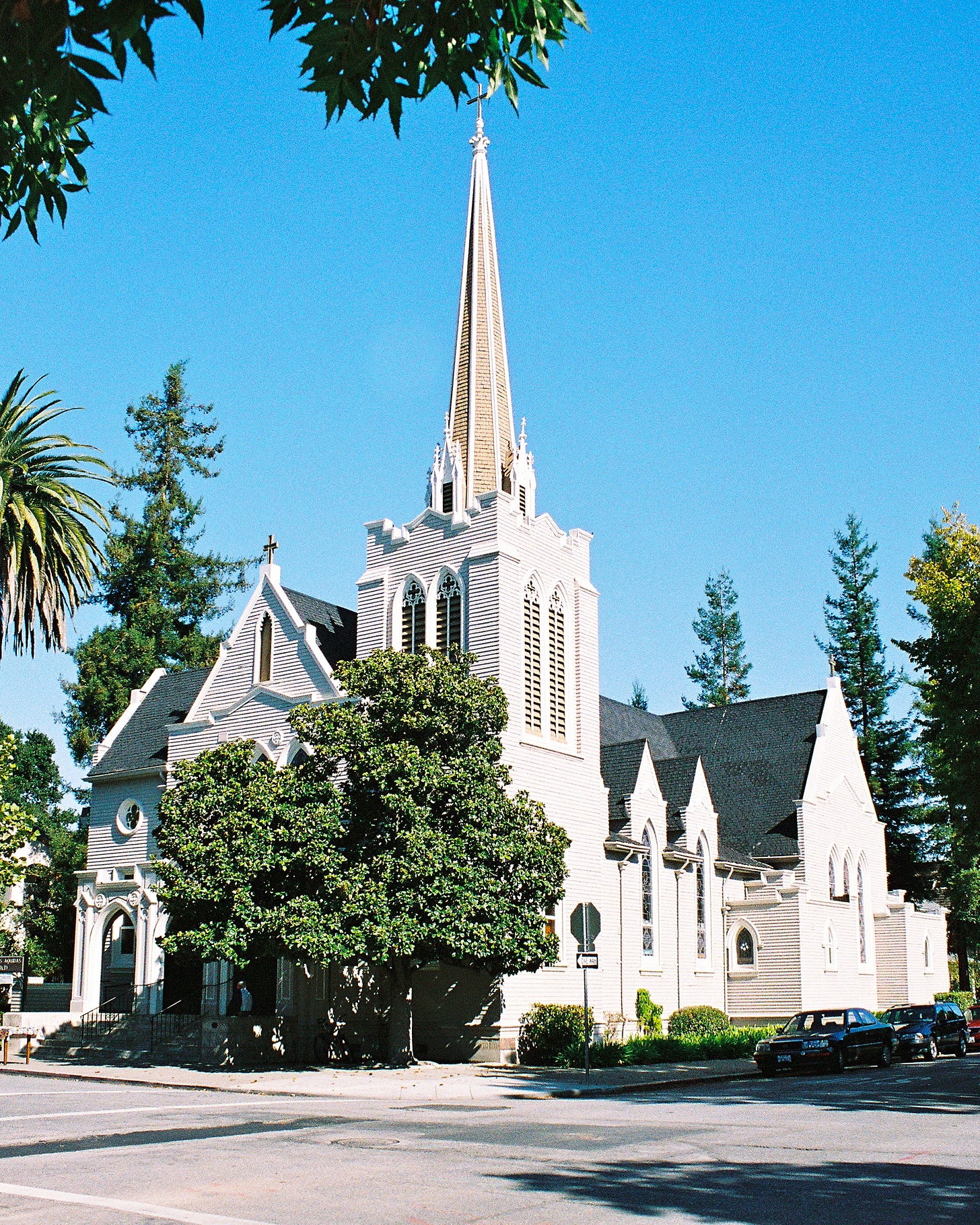
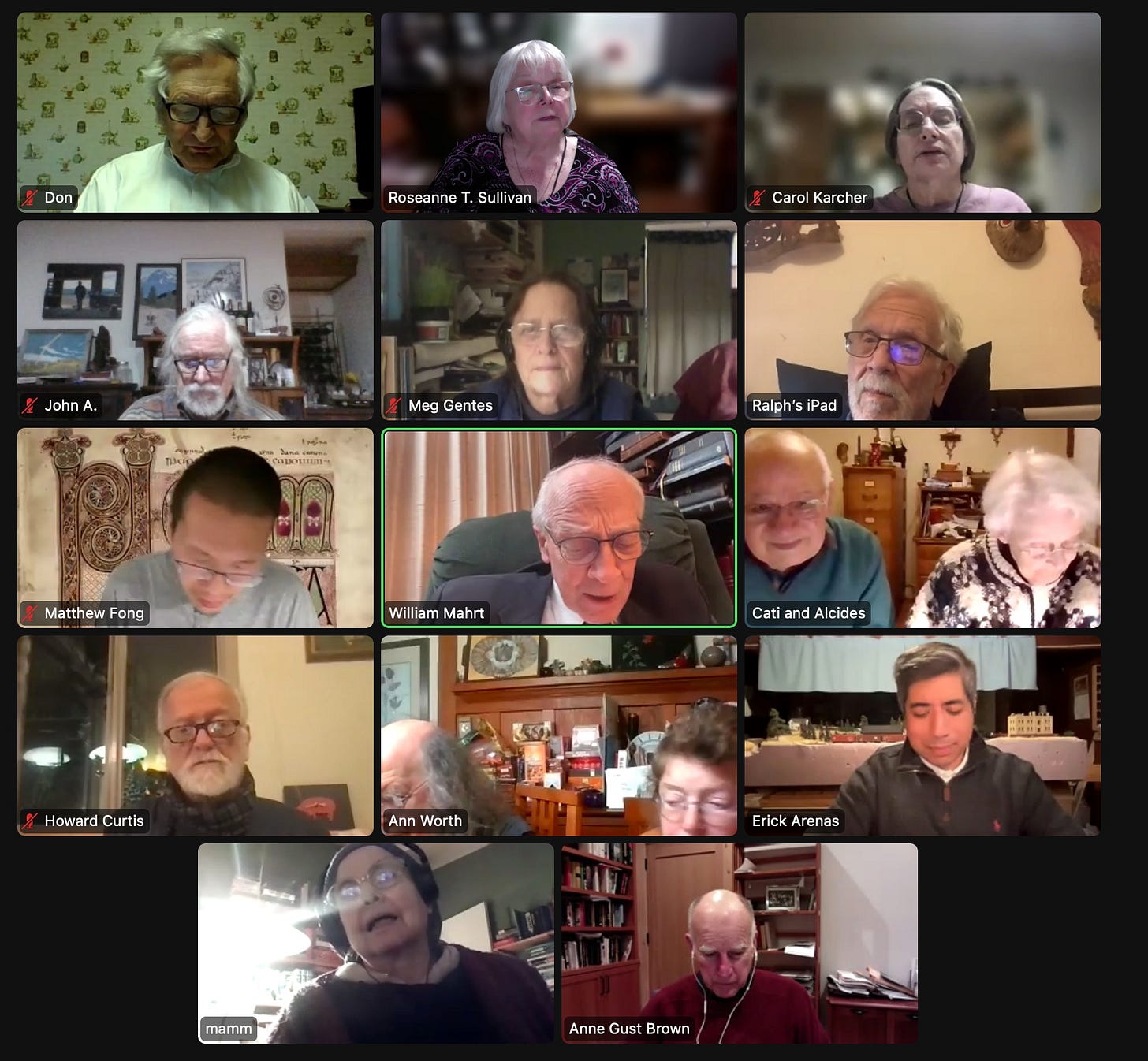

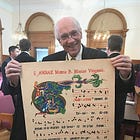
From email:
Thanks for sending this wonderful tribute to all of us
Love Susanw
The bakers at Costco had never written anything in Latin on a cake before. I thoroughly praised them!
[For the choir's 60th anniversary, Susan had ordered from Costco the chocolate cake with red roses. Its purple message crafted by the choir's Latin scholar Kevin Rossiter.]